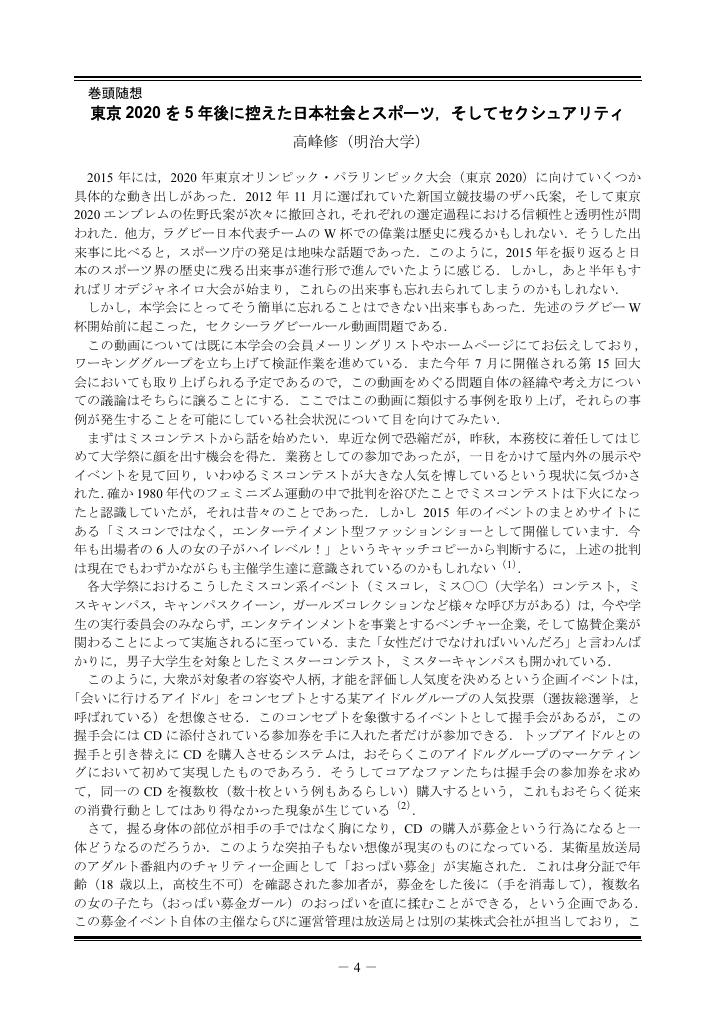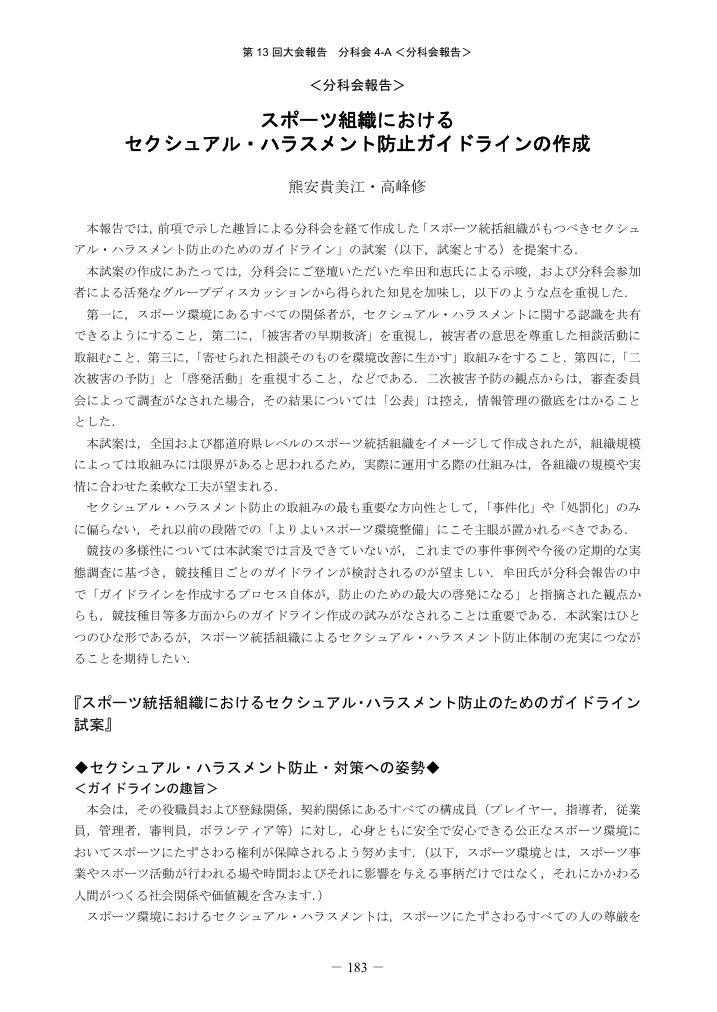2 0 0 0 OA 東京2020を5年後に控えた日本社会とスポーツ,そしてセクシュアリティ
- 著者
- 高峰 修
- 出版者
- 日本スポーツとジェンダー学会
- 雑誌
- スポーツとジェンダー研究 (ISSN:13482157)
- 巻号頁・発行日
- vol.14, pp.4-5, 2016 (Released:2017-04-25)
- 参考文献数
- 6
- 著者
- 高峰 修 飯田 貴子 井谷 惠子 太田 あや子 熊安 貴美江 吉川 康夫
- 出版者
- 日本スポーツとジェンダー学会
- 雑誌
- スポーツとジェンダー研究 (ISSN:13482157)
- 巻号頁・発行日
- vol.7, pp.16-28, 2009 (Released:2023-06-28)
- 参考文献数
- 5
- 被引用文献数
- 1
The purpose of this study is to examine the relationships among items of sexual harassment (SH) experienced by female Japanese college students inside of sport settings. Respondents were asked to answer whether or not they had experienced as SH 19 specific male behaviors toward female college students inside of sport settings. Data was collected by questionnaire. The survey was addressed to 4,208 students at 23 colleges, from June to November, 2003, and in October, 2006, and 3,989 students responded. Nine hundred ninety eight female students belonging to intercollegiate athletic clubs, and 477 female students belonging to intramural sport clubs were available for statistical analysis in this study. The experiences of SH inside of sport settings were first compared with respect to two types of sport clubs. Female students reported that they had been physically touched or massaged, or had been told jokes of a sexual nature. Among members of intercollegiate clubs, the percentage of persons who perceived “physical touching” behavior as SH was lower than that among members of intramural clubs. Intercollegiate club members reported their harassers to be instructors employed from outside their universities, while intramural club members reported them to be faculty members and upperclassmen in their clubs. Many female students reported that, when they experienced SH behavior inside sport settings, they shrugged of the behavior, did nothing, or were unable to do anything. Logistic regression analyses were conducted to examine the structure of behavior experienced as SH. Among intercollegiate athletic club members, “persistent sexual advances” as a dependent variable was significantly explained by three variables: “ask female students out to dinner or on a date,” “send e-mail with sexual content,” and “give female students a back/shoulder massage while giving instructions,” while among intramural club members, only “make female students serve tea or perform personal tasks” significantly explained “persistent sexual advances.” Finally, the importance of considering the structure of experienced SH items is discussed.
1 0 0 0 OA スポーツ組織における セクシュアル・ハラスメント防止ガイドラインの作成
- 著者
- 熊安 貴美江 高峰 修
- 出版者
- 日本スポーツとジェンダー学会
- 雑誌
- スポーツとジェンダー研究 (ISSN:13482157)
- 巻号頁・発行日
- vol.13, pp.183-192, 2015 (Released:2017-04-14)
- 参考文献数
- 4
- 被引用文献数
- 1
1 0 0 0 OA 男性学からみたスポーツをめぐる「女性の商品化」問題
- 著者
- 高峰 修
- 出版者
- 日本スポーツ社会学会
- 雑誌
- スポーツ社会学研究 (ISSN:09192751)
- 巻号頁・発行日
- vol.27, no.2, pp.17-27, 2019-09-30 (Released:2020-10-15)
- 参考文献数
- 18
本稿では、スポーツ領域における女性の商品化の問題を男性学の視点から検討した。この問題を検討するための事例として“セクシーラグビールール動画”、“女子プロ野球の美女9総選挙”、“プロ野球における女性の始球式” が取り上げられ、その内容が分析された。ワールドカップやプロリーグというホモソーシャルな場において、女性という存在はそもそも馴染まないか異質な存在である。そうした場に女性は受け入れられたが、その場に生じる違和感を緩和するために、女性はパロディ化されていた。さらに3つの事例における女性の表象には、異性愛主義を前提とする、女性に対する男性からの性的欲求、そして女性嫌悪が描かれていた。 次に、伊藤による男らしさを示す三つの志向性(優越志向・権力志向・所有志向)と性的欲望との関係について検討した。これらの志向性が女性に向けられるとき、男らしさは異性に対する性的欲求として表れる。スポーツの実践が現代社会における男らしさを学ぶ場になっているとすれば、そして男らしさに異性への性的欲求が含まれているのであれば、現代の男たちはスポーツを通じて、異性への性的欲求を自覚し、再確認し、あるいは実現しようとしていることになる。男たちがスポーツを通じて異性への性的欲求を実現しようとしている例として、始球式に登場した女性タレントが男子中学生たちに取り囲まれる事例を示した。
- 著者
- 高峰 修
- 出版者
- 日本スポーツとジェンダー学会
- 雑誌
- スポーツとジェンダー研究 (ISSN:13482157)
- 巻号頁・発行日
- vol.17, pp.87-102, 2019
- 著者
- 高峰 修
- 出版者
- 日本スポーツとジェンダー学会
- 雑誌
- スポーツとジェンダー研究 (ISSN:13482157)
- 巻号頁・発行日
- vol.14, pp.146-168, 2016 (Released:2017-04-25)
- 参考文献数
- 4


